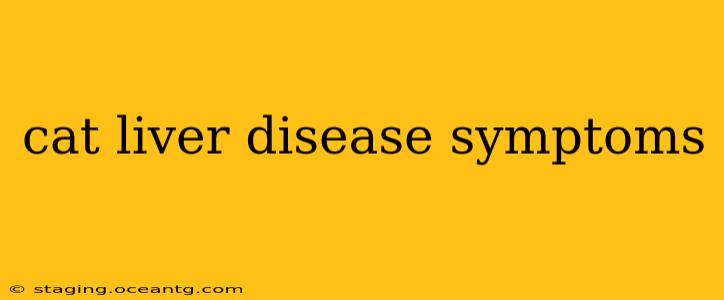Feline hepatic lipidosis (fatty liver disease) and other liver diseases in cats are serious conditions that often go unnoticed until they reach an advanced stage. Early detection is crucial for successful treatment, so understanding the symptoms is paramount. This comprehensive guide will explore common signs of cat liver disease, answering frequently asked questions to help cat owners recognize potential issues and seek timely veterinary care.
What are the early signs of liver disease in cats?
Early signs of cat liver disease are often subtle and easily missed, mimicking other common feline ailments. Owners might notice a decrease in appetite or a change in eating habits, such as picky eating or refusing favorite foods. Some cats experience weight loss despite maintaining a normal food intake. Lethargy and weakness are also common early symptoms, with cats becoming less active and playful than usual. Less noticeable signs include subtle changes in coat condition, such as dullness or increased shedding. Vomiting can also occur, but it's not always a consistent symptom in the early stages.
How do I know if my cat has liver problems?
Diagnosing liver problems in cats requires a veterinary examination. While the early symptoms mentioned above can be indicative, they aren't definitive proof of liver disease. Your veterinarian will perform a thorough physical exam, assessing your cat's overall health and looking for signs of jaundice (yellowing of the skin and whites of the eyes), which is a more advanced symptom. They may also order blood tests to check liver enzyme levels (ALT, ALP, bilirubin), which are often elevated in liver disease. Further diagnostic tests such as ultrasound imaging might be necessary to visualize the liver and assess its structure and function.
What are the symptoms of liver failure in cats?
As liver disease progresses to failure, symptoms become more pronounced and concerning. Jaundice (yellowing of the skin and whites of the eyes) is a hallmark sign of advanced liver disease. Ascites (fluid accumulation in the abdomen) is another common symptom, causing a swollen belly. Changes in bowel movements, such as diarrhea or constipation, might occur. Neurological signs, including tremors, seizures, or changes in behavior, can also manifest as the liver's ability to filter toxins from the blood diminishes. Anorexia (complete loss of appetite) and significant weight loss are also common in advanced stages.
Can cats recover from liver disease?
The prognosis for cats with liver disease varies greatly depending on the underlying cause, the severity of the condition, and the cat's overall health. Some forms of liver disease are manageable with appropriate treatment, allowing cats to live relatively normal lives. However, other cases can be life-threatening, and even with treatment, the outcome may be uncertain. Early diagnosis and intervention significantly improve the chances of recovery or successful management of the disease.
What are the common causes of liver disease in cats?
Several factors can contribute to liver disease in cats. Hepatic lipidosis (fatty liver disease) is a common condition often associated with anorexia or weight loss. Infections, such as those caused by viruses or bacteria, can also damage the liver. Toxins from plants, medications, or environmental exposure can negatively impact liver function. Genetic predispositions play a role in certain liver diseases, while other underlying conditions, such as diabetes or inflammatory bowel disease, can contribute to liver problems.
How is liver disease treated in cats?
Treatment for feline liver disease depends on the underlying cause and severity. Supportive care is crucial, often involving intravenous fluids to help improve hydration and nutrient support. Medications might be prescribed to manage specific symptoms, such as nausea or vomiting. In cases of hepatic lipidosis, nutritional support is critical, often involving a high-calorie, palatable diet. In some cases, surgical intervention might be necessary. The aim of treatment is to improve liver function, manage symptoms, and enhance the cat's quality of life.
This information is for general knowledge and should not replace professional veterinary advice. If you suspect your cat might have liver disease, consult a veterinarian immediately for diagnosis and treatment. Early detection and intervention are key to improving the chances of a positive outcome.
